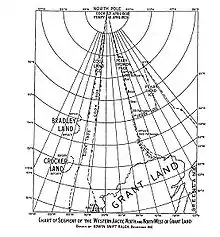| Bradley Land | |
|---|---|
 Alleged location of Bradley Land, sighted by Frederick Cook, and Crocker Land, sighted by Robert Peary. | |
| Created by | First reported by Frederick Cook |
| In-universe information | |
| Type | Large phantom island |
| Locations | Arctic Ocean |

Bradley Land was the name Frederick Cook gave to a mass of land which he claimed to have seen between (84°20′N 102°0′W / 84.333°N 102.000°W) and (85°11′N 102°0′W / 85.183°N 102.000°W) during a 1909 expedition. He described it as two masses of land with a break, a strait, or an indentation between.[1] The land was named for John R. Bradley, who had sponsored Cook's expedition.
Cook published two photographs of the land and described it thus: "The lower coast resembled Heiberg Island, with mountains and high valleys. The upper coast I estimated as being about one thousand feet high, flat, and covered with a thin sheet ice."[2]
It is now known there is no land at that location and Cook's observations were based on either a misidentification of sea ice or an outright fabrication. Cook's Inuit companions reported that the photographs were actually taken near the coast of Axel Heiberg Island.[3]
See also
References
- ↑ Balch, Edwin Swift (1913). The North Pole and Bradley Land. Philadelphia: Campion and Company. p. 54.
- ↑ Cook, Frederick A. (1911). My Attainment of the Pole: Being the Record of the Expedition that First Reached the Boreal Center, 1907–1909. New York: The Polar Publishing Co. p. 246.
- ↑ Bryce, Robert M. (2008). "Fredrick A. Cook: From Hero to Humbug". Retrieved 2009-02-23.